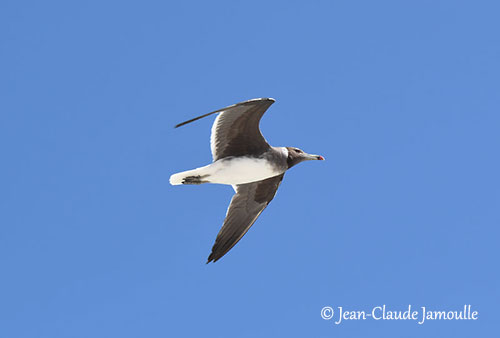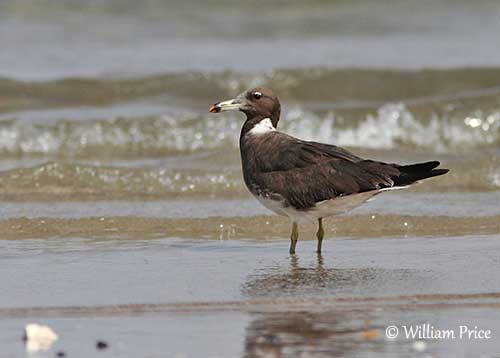
Fr: Goéland de Hemprich
Ang: Sooty Gull
All: Hemprichmöwe
Esp: Gaviota Cejiblanca
Ita: Gabbiano dal collare
Nd: Hemprichs Meeuw
Sd: sotmås
Photographers:
Jean Michel Fenerole
Photos d’Oiseaux du monde
Steve Garvie
RAINBIRDER Photo galleries & Flickr Rainbirder
Jean-Claude Jamoulle
A la rencontre des Oiseaux
William Price
PBase-tereksandpiper & Flickr William Price
Text by Nicole Bouglouan
Sources:
HANDBOOK OF THE BIRDS OF THE WORLD Vol 3 by Josep del Hoyo-Andrew Elliott-Jordi Sargatal - Lynx Edicions - ISBN: 8487334202
OISEAUX DE MER – Guide d’identification de Peter Harrison – Editions Broquet (Canada) – ISBN-10 : 2890004090 – ISBN-13 : 978-2890004092
THE HANDBOOK OF BIRD IDENTIFICATION FOR EUROPE AND THE WESTERN PALEARCTIC by Mark Beaman, Steve Madge - C. Helm - ISBN: 0713639601
Gulls: A Guide to Identification. 2nd Edition De P.J Grant – Editeur: Bloomsbury Publishing, 2010 – ISBN : 1408138298, 9781408138298 – 352 pages
Birds of the Horn of Africa: Ethiopia, Eritrea, Djibouti, Somalia and Socotra Par Nigel Redman, Terry Stevenson, John Fanshawe – Helm Fields Guides – Editeur: Bloomsbury Publishing, 2010 – ISBN: 1408135760, 9781408135761
Nest Site Selection by Sooty Gulls on Jarnein Island, United Arab Emirates
Prey-dropping behavior in Sooty Gull, Larus hemprichii
Wikipedia, the free encyclopaedia
Sooty Gull
Ichthyaetus hemprichii
Charadriiformes Order – Laridae Family
INTRODUCTION:
The Sooty Gull is native to the Red Sea and to the east coast of Africa, with a range extending as far E as Pakistan, and as far S as Tanzania and Mozambique.
This species is mainly coastal and is often observed near harbours and settlements. It usually nests on islands and on the ground, solitary or in small colonies with other seabirds.
This gull is a predator and a scavenger, and feeds on aquatic prey and offal, but eggs and chicks of other seabirds are also part of the diet. Very opportunistic, it is also known for stealing prey to other seabirds.
The Sooty Gull is vulnerable to oil spills and egg-collection by humans in Pakistan, involving the decline of the population. But the species is not globally threatened for the moment.

DESCRIPTION OF THE BIRD:
Biometrics:
Length: 44-47 cm
Wingspan: 105-118 cm
Weight: 400-510 g
The Sooty Gull in breeding plumage has sooty-brown hood extending down on to the upper breast in a dark bib contrasting with a white collar on the neck sides, becoming narrower at base of the nape. Mantle, back and upper breast are dark greyish-brown. The wings are dark brown, both above and below, and show a white trailing edge, except on the primary flight-feathers. Flanks are dark too, whereas belly, rump, uppertail-coverts and tail are white.
The long, thick, straight bill is bi-coloured at all ages. It is yellowish-green with red tip bordered with black at rear, whereas the extreme tip is yellow. There is a white crescent above the brown eyes. Long legs and webbed feet are yellowish-olive.
Male and female are similar.
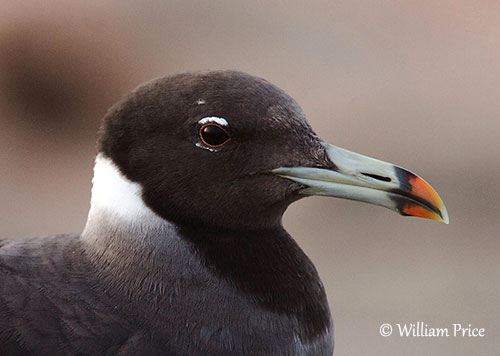
The non-breeding adult shows similar pattern but the hood is slightly paler.
The juvenile is mostly pale grey-brown with paler head and breast than adult. A scaly pattern is formed by the broad, pale fringes of both mantle and scapulars feathers, and by the upperwing-coverts. We can see two narrow white wingbars. The flight-feathers are darker brown. The white trailing edge is like in adult. The tail shows a broad, blackish terminal band.
The bill is pale greyish to blue-grey with black tip. Legs and feet are grey.
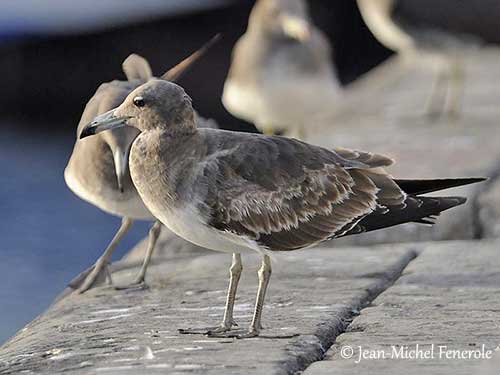
1st winter and 1st summer resemble juvenile but with uniformly brown mantle and scapulars, creating a dark “saddle”. Hood and bib become darker in 1st summer.
2nd winter resembles adult but hood and bib are paler. The white half-collar is very indistinct. The tail shows variable dark band. The flight-feathers are blacker. The legs are becoming greener and the reddish bill tip develops only by 2nd summer or 3rd winter.
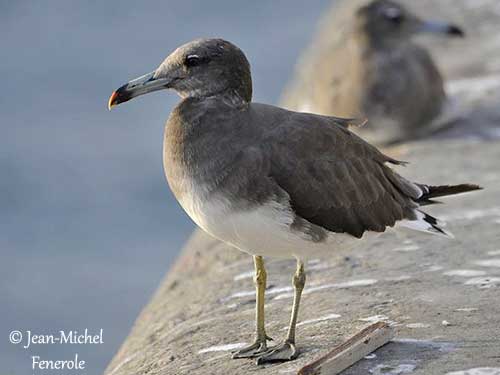
RANGE:
The Sooty Gull breeds in Red Sea and Gulf of Aden, and also Persian Gulf and Gulf of Oman, E to S Pakistan and S to NE Kenya (especially Kiunga Island).
Some birds winter S to N Mozambique.
HABITAT:
The Sooty Gull breeds on offshore islands and usually on the ground. It forages on mainland beaches and coral reefs, and it is often seen near harbours and human settlements. It is mainly coastal but it also follows the fishing boats.
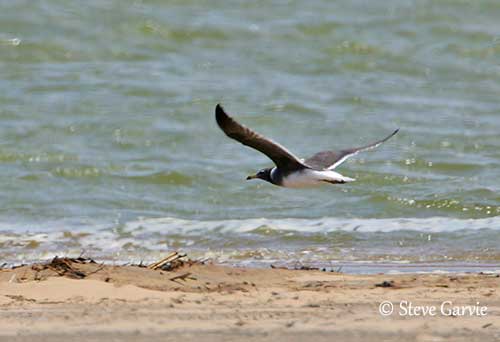
CALLS AND SONGS: SOUNDS BY XENO-CANTO
The Sooty Gull is noisy when in flocks, whereas the single birds are rather quiet. Members of the flocks give nasal, down slurred “weeooo… weeooo…” calling in loud chorus.
The alarm call is a Herring Gull-like “ke-ke-ke-ke”. On the breeding grounds, the long call is a series of loud, screaming notes progressively dropping in pitch. It is described as a loud “kioow” repeated 12-16 times.
BEHAVIOUR IN THE WILD:
The Sooty Gull feeds mainly on dead fish, offal, eggs and chicks of other seabirds, turtle hatchlings, prawns and small fish.
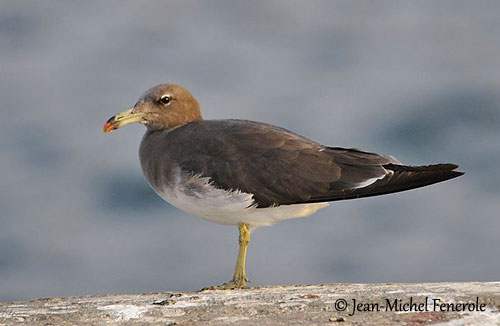
From an observation in Egypt, two adults have performed “prey-dropping” behaviour before to eat the food. This behaviour is well known but not in this species.
One gull was carrying a large bivalve of family Verenidae in the bill while rising in flight up to six metres above the ground. Then, it dropped the shell on the rock below. The shell broke immediately and the gull dived head first to eat the mollusc. This behaviour was repeated by the first gull and another one, both with success (Fulvio Fraticelli - Fondazione Bioparco di Roma, SROPU).
This species is rarely seen performing plunge-diving for fish. It feeds mainly inshore and in intertidal zone, sometimes up to 100-150 kilometres offshore where it follows fishing boats for offal. It is very opportunistic and is known for stealing food from other seabirds.
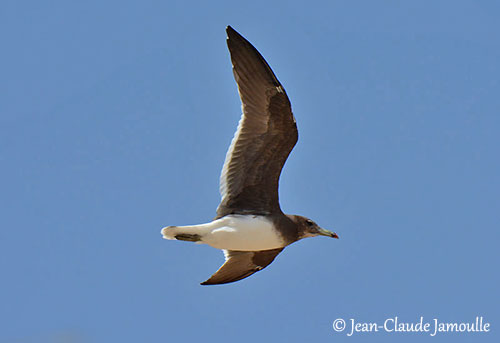
The Sooty Gull breeds in summer, in small colonies but sometimes solitary. It breeds on islands and may frequent several habitats types such as dense vegetated areas, gravel habitat, rocky habitat and sandy areas. But from a study, this species prefers rocky substrates.
The Sooty Gull from the Red Sea usually remains in this area all year-round. We can observe a post-breeding dispersal southwards, with birds reaching Tanzania and sometimes N Mozambique. It is a winter visitor to Kenya coast.
Vagrants can be seen in Israel, Jordan, Lebanon, India, Sri Lanka, Maldives and Seychelles.
The flight is slow but steady, like in larger gulls.
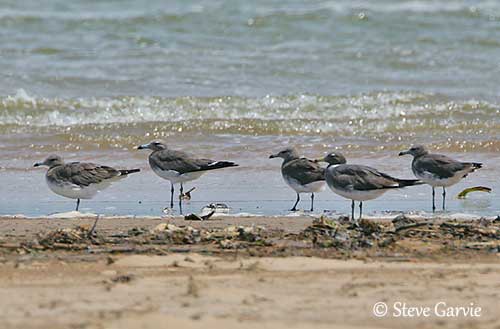
REPRODUCTION OF THIS SPECIES:
The Sooty Gull breeds during summer, from June to October depending on the range.
It nests in colonies with other seabirds, but it may occasionally nest solitary on inshore coral islands protected by reefs, with rocks, sand and sparse vegetation. The nest is a shallow depression on the ground with some vegetation used as lining. It is placed on bare coral, protected by a bush or a tuft of vegetation, or under low hanging coral.
The female lays 1-3 eggs. The incubation lasts 25 days, probably shared by both adults. Some young fledge in November, but more information is needed.
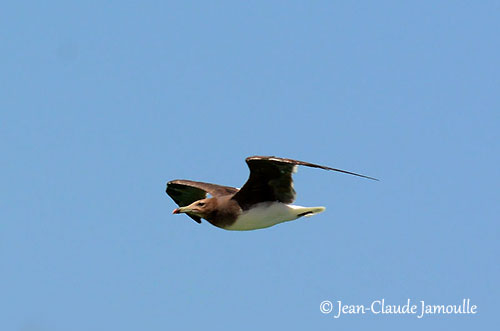
PROTECTION / THREATS / STATUS:
The Sooty Gull has a very wide range, but it is vulnerable to oil spills and degradation of the habitat caused by oil prospection in the Gulf region. Eggs are regularly robbed by humans in Pakistan, and egg-collection for human consumption occurs in the Seychelles.
The population is roughly estimated at 150,000/500,000 individuals, and it is suspected to be declining.
But the Sooty Gull is not globally threatened and currently evaluated as Least Concern.
